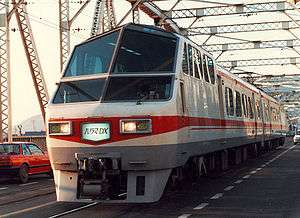Meitetsu 8800 series
| Meitetsu 8800 series | |
|---|---|
|
A 2-car 8800 series consist in 1986 | |
| In service | December 15 1984 - January 29 2005 |
| Manufacturer | Nippon Sharyo |
| Family name | Panorama DX |
| Number built | 12 cars (4 sets) |
| Number in service | None |
| Number preserved | 1 vehicle |
| Number scrapped | 11 cars (3 sets) |
| Formation | 3 cars (formerly 2) per set |
| Fleet numbers | 8801 - 8808, 8851, 8853, 8855, 8857 |
| Operator(s) | Nagoya Railroad |
| Line(s) served | Meitetsu Nagoya Main Line, Inuyama Line, Meitetsu Chita New Line |
| Specifications | |
| Car body construction | Steel |
| Maximum speed | 110 km/h |
| Electric system(s) | 1,500 V DC |
| Current collection method | Overhead catenary |
| Safety system(s) | Meitetsu ATS |
| Track gauge | 1,067 mm (3 ft 6 in) |
The Meitetsu 8800 series (名鉄8800系) is a limited express electric multiple unit type operated by Nagoya Railroad (Meitetsu) in Japan from 1984 to 2005.[1] It was used on Panorama DX services.
Formations
Original 2 car sets
The original 2 car trains were formed as follows:
| Car No. | 1 | 2 |
|---|---|---|
| Designation | Mc1 | Mc2 |
| Numbering | 880x (odd) | 880x (even) |
Later 3 car sets
The later 3 car sets, introduced from June 15, 1989, were formed as follows:
| Car No. | 1 | 2 | 3 |
|---|---|---|---|
| Designation | Mc1 | T | Mc2 |
| Numbering | 880x (odd) | 885x | 880x (even) |
History
The trains started service in 1984 as 2 car units. A third car was inserted between all sets starting from 1989. However, with the decline of tourism related services, the 8800 series were relegated to trans-city expresses. Originally, the fees paid by passengers who took "Panorama DX" trains were higher than those who took "Panorama Super" services; this was later changed so both services had the same fees. As the 8800 series only had a top speed of 110 km/h, compared to the top speed of 120 km/h on "Panorama Super" trains, the 8800 series were slowly taken out of service, with all being withdrawn by late January 2005, and scrapped by March the same year.
The 8800 series was the recipient of the 28th Blue Ribbon Award held in 1985.
Preserved examples
The front half of the cab section of unit 8803 has been preserved at the Mogi inspection yard.
See also
-
 Media related to Meitetsu 8800 series at Wikimedia Commons
Media related to Meitetsu 8800 series at Wikimedia Commons
References
- ↑ (in Japanese.) Nagoya Railroad. Retrieved 14 January 2011.
